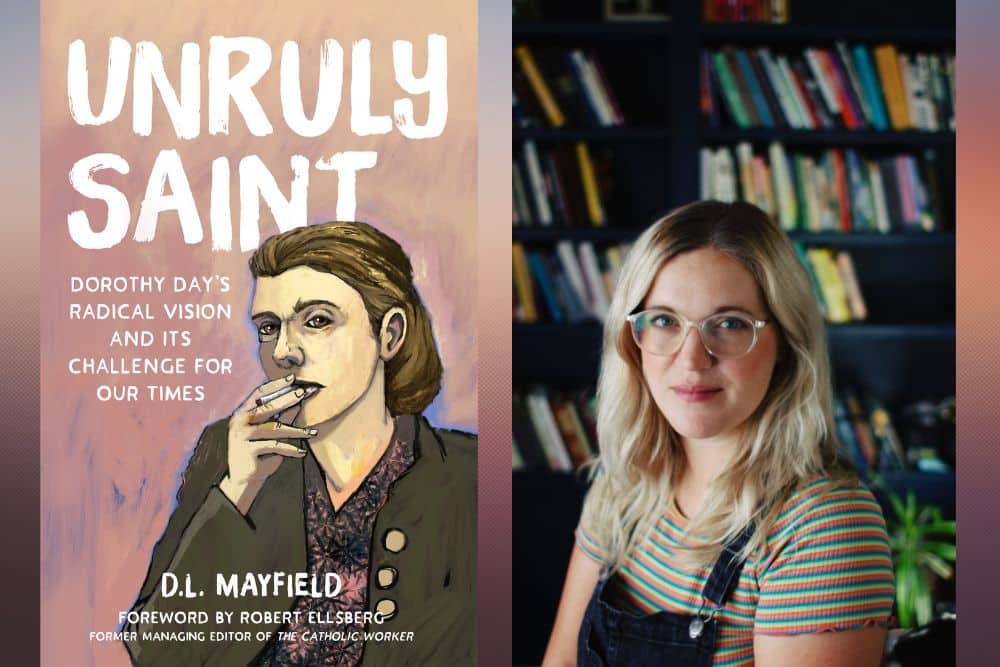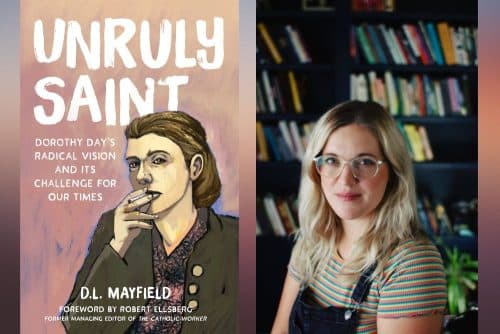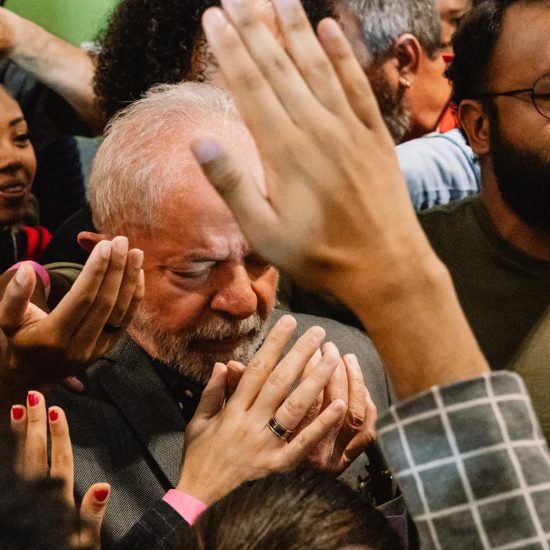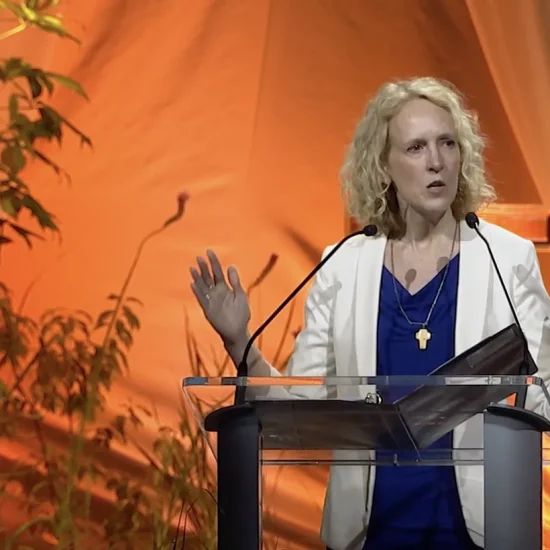

The book cover along with an author photo of D.L. Mayfield.
UNRULY SAINT: Dorothy Day’s Radical Vision and Its Challenge for Our Times. By D. L. Mayfield. Foreword by Robert Ellsberg. Minneapolis, MN: Broadleaf Books, 2022. 256 pages.
When Pope Francis addressed Congress he recognized Dorothy Day, founder of the Catholic Worker movement, along with Abraham Lincoln, Martin Luther King, Jr., and Thomas Merton as one of four great Americans of faith who “moved America’s moral and social imagination forward in distinct ways” (p. 7). This choice likely surprised many in Congress and beyond because in naming her, he named a radical pacifist labor-supporting Roman Catholic layperson. Yet that’s what he did. Others have called her a saint (she is currently being considered for sainthood). If she is a saint, then what kind of saint is she? While her willingness to give up everything to care for those in great need, advocate for workers, and oppose American wars, has caught the attention of many admirers, one might wonder if she would want such an honor, especially if in doing this the Church ended up domesticating her memory.

Robert D. Cornwall
If you are like me, you know the name Dorothy Day. You may know that she helped found the Catholic Worker movement. You may know that many social justice advocates look up to her. But do you know her story? Do you know how this one-time Marxist-leaning, labor-organizing journalist, who once had an abortion, could become a near saint? I will confess that I didn’t know much about her until I opened up D. L. Mayfield’s book Unruly Saint. That title may sound odd, but by the time you finish reading this book, you will understand why Mayfield chose to give the book this title.
Mayfield offers us in Unruly Saint a biographical study of Day’s life, with a focus on her role in the Catholic Worker movement. In other words, if you’re looking for a comprehensive biography of Day, this isn’t it. However, she does provide significant biographical details, which is because Day’s biography is the foundation of her involvement with the movement. As for the author, D.L. Mayfield is not Roman Catholic. Her spiritual location might best be described as post-evangelical. In addition to this new book, Mayfield has authored two other books. She is also a self-described activist who has taught ESOL to immigrant and refugee populations. In other words, though not Catholic, she can identify with Day’s activism.
In this book, Mayfield approaches Dorothy Day as something of a fellow traveler. She doesn’t aspire to the asceticism that Day embraced or put others before herself in the way Day did, but Mayfield seeks to identify as much as possible with Day and her commitments to justice and the well-being of others. She recognizes a degree of saintliness about Day’s life but fears she might get domesticated by a church that might use her memory in ways that do not reflect who she was. Most of all Mayfield wants the reader to know that Day may have died in 1980, but she remains relevant today.
What makes Day’s story so compelling is that before her conversion at age 30, she was on a life path that didn’t lead toward the church. Nevertheless, once she found the church, she wanted to make sure her new-found faith fit with her commitment to serving the poor and the oppressed. The key to her life vocation is her encounter with a French “philosopher-hobo” named Peter Maurin, who helped her discover her calling to create what became the Catholic Worker movement. That movement began with a newspaper she launched in 1933, which was followed by a house of hospitality to house the homeless. Then later she added farms and communes to help those in need. All of this is part of the story that Mayfield weaves together.
In her introduction, Mayfield notes that she discovered Day at a point when she was in the midst of a personal crisis and trying to figure out who she was spiritually. Growing up in white evangelical circles where she had resided spiritually no longer worked. As she went looking for something else to sustain her spiritually, she encountered Day. Therefore, this is a very personal book that seeks to take Day’s life and work very seriously as in it she found a sense of direction.
Mayfield breaks Unruly Saint into three parts. She starts appropriately in Part 1 with a series of chapters that introduce us to Dorothy Day’s early life. Thus, we begin with her birth in 1898 and continue to her conversion at age 30 in 1927. Her conversion shocked her friends since it didn’t fit what they knew of this chain-smoking writer for leftist papers who impatiently sought to change the world. How did this “pregnant-out-of-wedlock free spirit who could quote Marx with the best of them and was always ready with a sarcastic retort or a girlish giggle” convert to Catholicism? (p. 22). For Day, as we discover, it was her commitment to serving the poor that led her to God and eventually the Catholic Church, even though she grew up in a nominal Episcopalian family. Part of her conversion story involved the birth of her daughter Tamar, which helped clarify her sense of identity and life purpose. It was during this early period of her life, as she began to move into the church, that she took her muckraking style of writing that she had used in writing for leftist papers to Catholic publications such as Commonweal.
While covering labor issues as a journalist, Day started wanting to do more in support of those who labored. Her turn to embracing religion in this effort emerged as she watched Communists demand that people seeking justice leave religion for the class struggle. “She was angry at how they overlooked the reality that large percentages of the poor workers around the world were not only religious but Catholic. How could one claim to be for the common worker of the world and dismiss their religion as intellectually depraved and morally corrupt?” (p. 70). That is a relevant question for contemporary liberals who often dismiss religion. After covering a major labor march, she returned to her home in a New York tenement. When she arrived at her apartment, she encountered an older man in rumpled clothes who had come looking for her. That encounter would lead to the creation of the Catholic Worker, a muckraking paper that became the foundation of a movement in support of workers that emerged within the pre-Vatican II Roman Catholic Church.
As we turn to Part 2, Mayfield begins her exploration of the birth of the Catholic Worker journal. This begins with Day’s meeting with Peter Maurin that day at her apartment. It was Maurin who encouraged Day to turn her passion for justice and writing ability to create a justice movement within the church. Maurin may have looked like a hobo, but he was trained in theology and philosophy. With that intellectual background, he sought to marry Catholic social teaching with this philosophy. As such he served as the intellectual foundation for what became Day’s life work. The goal here was to change the world. Together with his ideas and her energy and writing ability, they laid the foundations for that justice movement.
Although they had hoped to convince church leaders to embrace their vision and begin creating what they called houses of hospitality in every congregation, that effort failed to bear fruit. Nevertheless, their vision caught on as thousands subscribed to the journal. With that, she began to influence Catholics, encouraging them to commit themselves to create space and support for those in need. The Catholic Worker journal was born in 1933, at the height of the Great Depression. After this came the houses of hospitality, which ultimately began when people showed up on Dorothy’s doorstep needing housing and help. Most importantly, for her part, she was spreading the word about Catholic social teaching, which not everyone in the hierarchy appreciated. The first house was opened in 1934. as Dorothy was busy renting apartments to house all those who were homeless.
Mayfield notes that even as Day was embarking on this justice work, she was not impressed with government-sponsored programs. Therefore, she sought to do things differently. Nevertheless, despite not being a fan of government efforts, she recognized the need and chose to help people get signed up for the relevant government programs. These qualms about the nature of these programs have unfortunate contemporary implications since some opponents of current government programs will appeal to her concerns. However, the way that they do this is contrary to her understanding of the situation she faced. Interestingly, her problem with the government programs wasn’t rooted in religious beliefs, but rather in a deep-seated anarchist bent that predated her conversion. I guess that those who seek her endorsement for their efforts wouldn’t embrace her anarchist beliefs. As a reader, I found that Mayfield does a good job navigating these concerns and suspicions.
As for the origins of this burgeoning movement that Day and Maurin launched, Mayfield notes that the stories are “full of humor and failure and grassroots camaraderie and heady days.” (p. 154). Over time the movement grew, setting up shop across the country with each having its distinct feel. Mayfield writes of this work of living out Catholic social teaching in seeking to create a better world: “Love in action could be a harsh and dreadful thing, but it was certainly never, ever boring.” (p. 154).
Mayfield’s focus in this book is not on the entirety of Day’s life, but rather on the origins of the Catholic Worker movement, which she lays out in Part 2. That effort takes off in 1933 when Day was 35 years old. While she focuses her attention on the early days of the movement, Mayfield doesn’t neglect the ongoing work of that movement. So, in Part 3, titled “The Work Continues,” Mayfield shares with the reader how the work matured over time. This section includes a discussion of the problems that emerged due to her commitment to pacifism. Her pacifism led to problems with her Church (this was especially true during the Spanish Civil War in 1936 because the Roman Catholic Church in the United States supported Franco in that war) as well as with the Church and the United States government during World War II, when she took a strong stand against the war. This commitment led to a steep decline in support for her movement since she would not let go of her commitment. That commitment even led to the FBI putting her on a watchlist. While her earliest efforts focused on labor issues and the realities of poverty, including homelessness, over time she gave more attention to her commitment to pacifism and along with addressing the realities of racism in the country. Mayfield was surprised by how often articles on race appeared in the early issues of the journal.
Interestingly, in her later years, Day experienced a second conversion that brought her under the influence of a rigorist version of Catholicism. This version of Roman Catholicism seemed to give her a sense of grounding, but it also alienated many of her co-workers and family members. Mayfield shares how a certain figure, Fr. Hugo, led silent retreats at the Catholic Worker farm that called for a severe form of asceticism that involved giving up the best things in life (including familial relationships).
As we read through this book, we encounter an Unruly Saint who is in every way a radical Christian who gave her all for her cause. At times that commitment led to her neglecting members of her own family, which led to a break with her daughter at one point. Fortunately, the two were reconciled, but we might see in this part of the story a warning to us about collateral damage as a result of taking a radical position when it comes to living out one’s faith. Perhaps that’s why some take to the life of the ascetic, eschewing family and friendships. Day tried to have both and in doing so her family at times suffered. For Protestant readers, sainthood is not part of our normal way of being Christian. However, we do tend to receive some of the saints of the Roman Catholic Church into our own lives. Perhaps that will be true of Dorothy Day should she be canonized. If she becomes an official saint of the church, then certainly she is an unruly one. We can thank D. L. Mayfield for helping us get to know this woman who might be a true saint. Hopefully, if that comes to pass, she’ll remain an unruly one, as Mayfield suggests, rather than a domesticated one who proves useful for those who are not interested in Dorothy Day’s commitment to justice.
This review originally appeared on BobCornwall.com.
Robert D. Cornwall is an ordained minister in the Christian Church (Disciples of Christ). Now retired from his ministry at Central Woodward Christian Church (Disciples of Christ) of Troy, Michigan, he serves as Minister-at-Large in Troy. He holds a Ph.D. in Historical Theology from Fuller Theological Seminary and is the author of numerous books including his latest books: Called to Bless: Finding Hope by Reclaiming Our Spiritual Roots (Cascade Books, 2021) and Unfettered Spirit: Spiritual Gifts for the New Great Awakening, 2nd Edition, (Energion Publications, 2021). His blog Ponderings on a Faith Journey can be found at www.bobcornwall.com.






